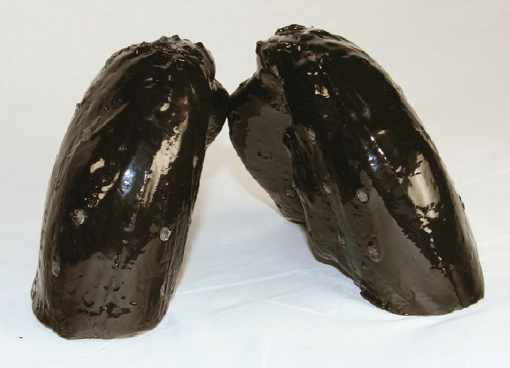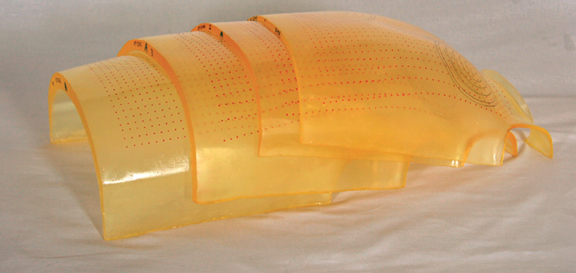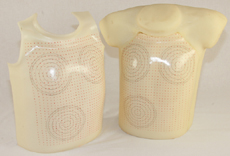The Lawrence Livermore Realistic Phantom RS-500
A Worldwide Reference Standard for In-Vivo Counting
The Lawrence Livermore Realistic Phantom was developed under the direction of the U.S. Department of Energy, primarily as a reference standard for the in-vivo counting of emissions from low-energy transuranic nuclides.
The organs of interest are the lungs, liver and lymph nodes. Each of these may be radioactive or inert. These organs are accommodated in a male thorax generally similar to average adult males.
The Livermore phantoms contains a synthetic bone skeleton molded within a soft-tissue-equivalent material. The organs are located in an internal cavity with a separate torso cover that closes the phantom. Anterior sections of ribs and the sternum are molded into this cover.
Soft-tissue-equivalent blocks are used to position the organs and fill significant air spaces, providing continuity of the soft-tissues throughout the phantom. The phantom is shipped assembled with inert organs. Any or all of these organs can be replaced with radioactive organs, which are shipped in separate packages.
OrgansAll organs are made of soft-tissue equivalent materials. Lungs are available with the nuclides uniformly dispersed throughout the lung molding material. Optional organs (developed by RSD and not part of the original DOE specifications) are inert, but have holes in 2 cm2 grids. These either can be filled with inert plugs or with active capsules to establish any desired distribution within the lungs.
 Lungs |
 Chest Overlay Plates |
The liver has the same loading flexibility, but another options is available, designed for use with solutions having relatively short half-lives. This liver is a hollow shell with a fill/drain port.
If the liver is not required, it may be replaced with the Abdominal Contents, which are also available with a hole matrix, or active.
Lymph nodes are available as hollow shells or as active packets. Two are 8 mm in diameter by 17 mm long. A third is 13 mm in diameter by 25 mm long. They are positioned in recesses molded in a lymph mode block.
Chest Overlay PlatesTransuranic emissions from individuals with varying amounts of muscle and/or adipose tissue may be so attenuated as to be undetectable. Chest overlay plates were developed to ensure the validity of in-vivo counting of such individuals.
There are three sets of plates, each in four graded thicknesses. One set is equivalent to 87% adipose and 13% muscle, another is equivalent to 50% muscle, and the third is equivalent to 100% muscle. Plates of each material and/or each thickness are available separately.
TargetsThree sets of concentric circles are drawn in permanent black ink over the torso cover and over each chest overlay plate. They range in 1 in. increments from 1 in. to 5 in. in diameter, with a 5.5 in. diameter outer circle. One set of circles is places over each lung region, with the outer circle tangent to the inferior aspect of the clavicle and protruding over the sternum. The third set is placed over the liver.
A 2 cm2 grid is projected in red ink over most of the chest surface by the same technique that is used for the circles. All targets are consistent among all phantoms
| Livermore Ograns | |||
| Organs | Inert, Hole Matrix | Solid, Active | Inert, Hollow |
| Lungs | N/A | RS-503A | N/A |
|
Lymph Nodes (set of 3) |
N/A | RS-506A | RS-506S |
|
Liver & Liver Envelope |
RS-707H |
RS-508A (Liver only) |
RS-519S (Liver only) |
|
Abdominal Contents* |
RS-510H | RS511A | N/A |
*Replaces Liver and Liver Envelope
| Chest Overlay Plates | |
|
RS-513 (1,2,3,4) (A,B,C) |
Chest Overlay Plate (Any of 4 thicknesses) #1 - thinnest, #4 thickest A) 87% adipose - 13% muscle B) 50% adipose - 50% muscle C) 100% muscle |
|
RS-514 (A,B,C) |
Chest Overlay Plates Set of 4, in materials A, B, or C |



